Successful gym branding is paramount to building a strong following—regardless of which workouts you offer. If you want people to choose you over other competitors then you need to offer something niche to the right audiences. And from fitness apps to chains offering clients state-of-the-art facilities for cheap memberships, it’s stiff competition out there. So warm up your gym branding strategy fully with our ultimate guide and don’t worry about breaking a sweat later on in the game.
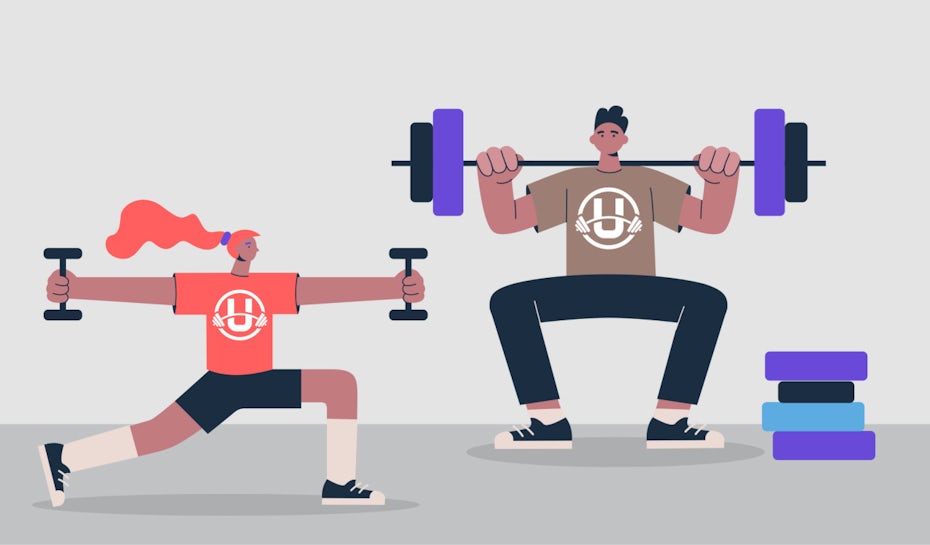
Why does a gym need branding?
—
With so much alluring variety out there, for continued and steady success, a gym needs customers who sign up for memberships or regularly drop into classes. Branding your gym successfully will help you build relationships with customers to get just that; it’ll help your gym to become a staple in their routine.
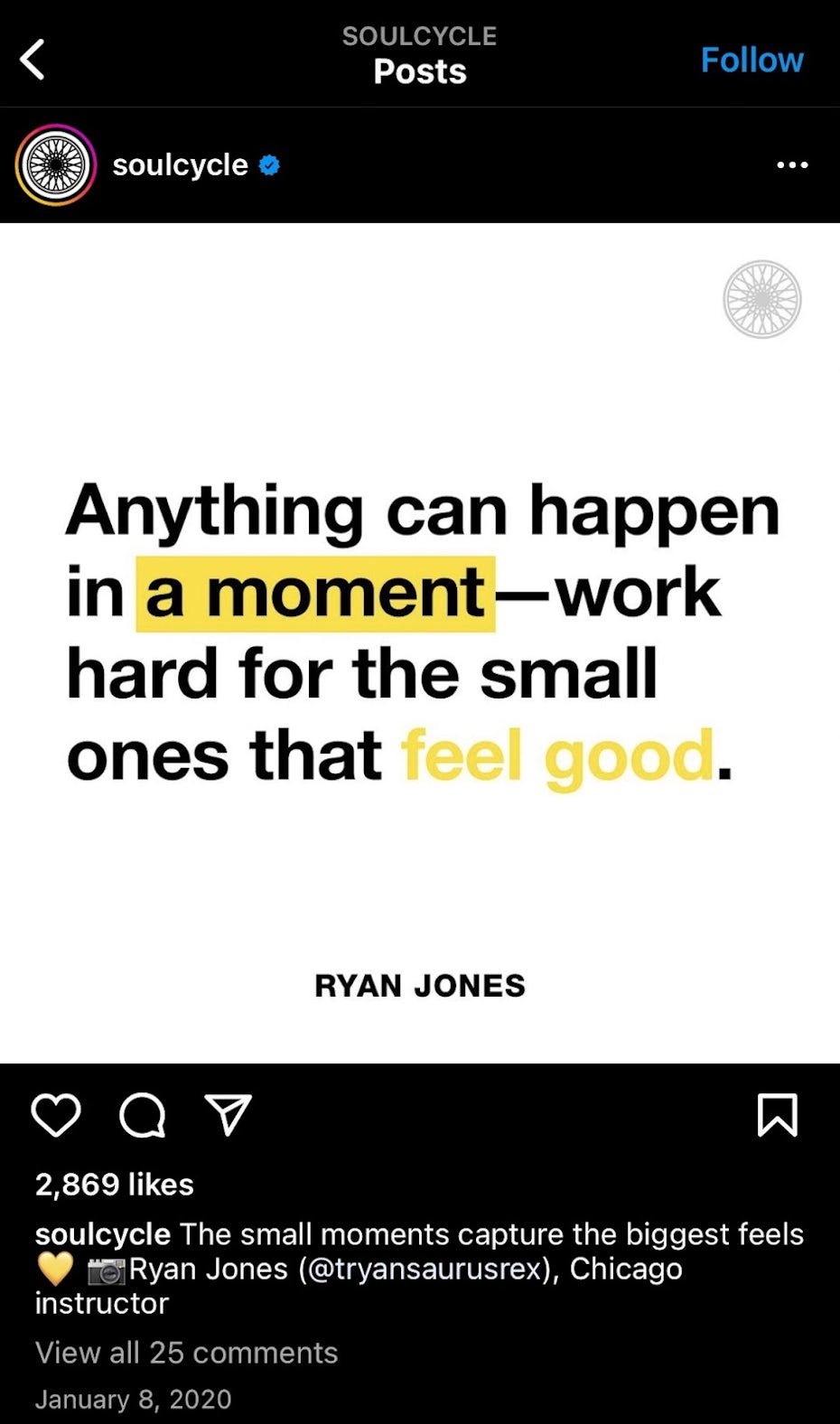
And say yours is a smaller gym looking to expand, branding will help you be known wherever you go. Let’s briefly think about how SoulCycle began back in 2006 with only one studio and expanded to now have over 99 locations. Their branding strategy involved creating a workout and studio that could easily be repeated in other locations. Some of their most notable features are a candlelit spinning room, a 45-minute class format involving pretty much the same sequence in each class, and an extremely motivational brand personality, expressed through neon signs and instructors.
When they first started, these features and the motivation-driven, spinning-only studio wasn’t something that was common at all. Now similar cycling studios that emulate SoulCycle’s branding can now be found in major cities around the world. By creating a brand with notable, memorable and (at the time) unique elements, SoulCycle grew with a loyal following.
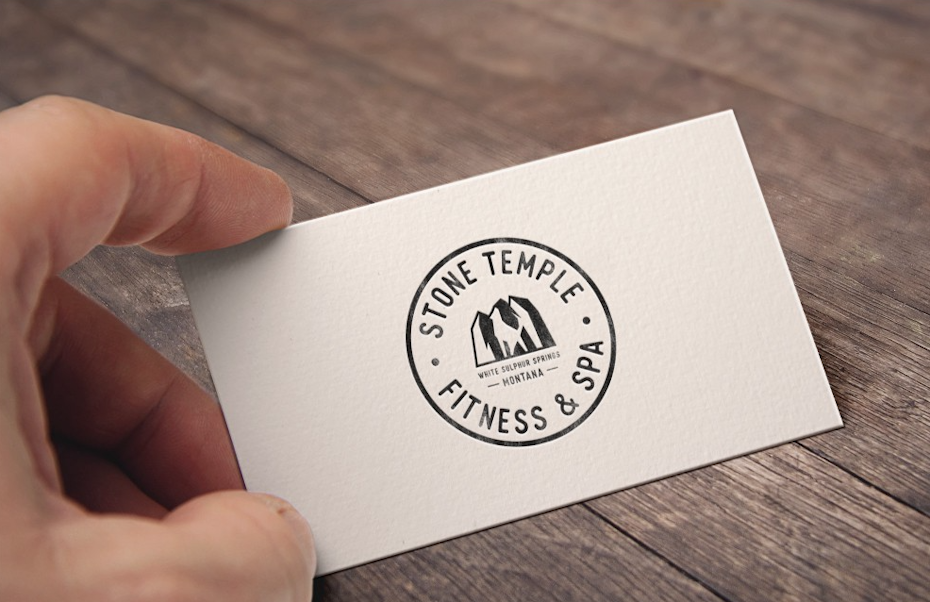
So, good gym branding will:
- Set the gym apart from the competition
- Build an audience and create a niche for the business
- Market the gym better and more consistently
So what do you need to do to brand your gym?
How to create a gym brand
—
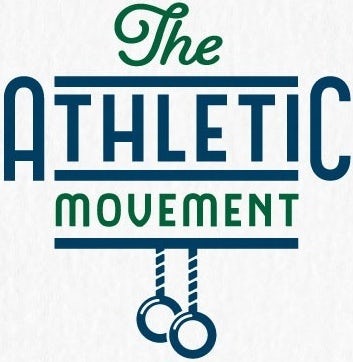
Branding has to be curated for each industry and business model. For example, packaging might not be as relevant for a digital product as it is for a food item. So in order to brand a fitness business, it’s necessary to have a comprehensive understanding of all the elements that can go into such a brand.
Let’s start out by thinking about what the components that make up a gym brand can be: a studio, signage, workout types, nutrition options, merchandise, staff, website, social media channels, an app… etc, etc.
Although you can choose to stick to the essentials, it’s good to recognize there are plenty of branding opportunities when it comes to a gym. And that is exactly what each of these elements are, an opportunity for customers to better understand and develop a relationship with your gym.

And connecting with customers on a personal level is crucial to a gym brand. A gym is a lifestyle to many. These establishments often involve memberships and long-term commitments, favorite teachers and favorite equipment. A gym has a personality. And that takes us to our very first step: establishing a brand strategy.
1. Define who you are as a brand:

There’s definitely more to a fitness business than meets the eye. The main question to answer is why should the clientele exercise and why should they do it at this particular gym over others? Answering these existential questions will reveal the core of a gym’s brand strategy and your mission statement. The goal is to come up with a clear, short and direct statement that is your purpose.
Here are some questions to ask when describing your gym brand:
What are your values?
To figure this out, you have to think about the emotional driving force behind your gym brand. And it has to be deeper than profitability, success and recognition.
Perhaps it’s to offer people ways to learn self-defense. Or it could be a space that dedicates itself to body positivity. Maybe you would like to have a rehabilitative space that is more welcoming for those who have suffered injuries or who are more injury-prone due to age or a health condition. Your gym may value minute attention towards customers or give them space to do their own thing.
Clarifying what’s at the heart of your brand will serve as a guide for what the rest of your gym branding should look like.
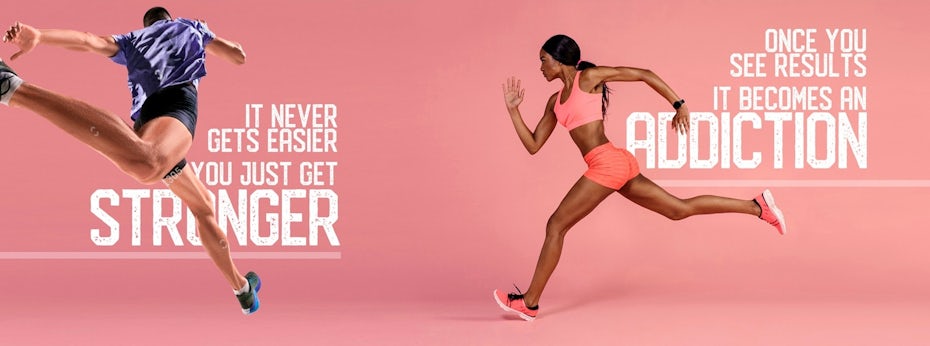
Who are you as a gym?
This is the part where you turn your gym into a character. Give it shape and life. It’s related to what your gym sounds like, looks like, speaks like. If your gym were a person, what sort of personality would it have? To work on this, you can imagine yourself interacting with your gym as an outsider. What are the colors you see on an ad for your gym? What is the tone of the language?
And then think about entering the physical space that is your gym. What do you find? Maybe it is a highly energizing and exciting experience, with bright lights with exercises that push you to the limits, gets your heart pumping. Your gym is a challenger, someone that wants everyone to beat their personal bests. Or, perhaps you find yourself in a caring and soft space, with herbal teas on tap, lots of cushiony surfaces, meditation rooms, ample space to stretch like a cat? Your gym is a calming haven.
These are just some of the many, many options for what a gym could be. Figuring out just exactly who you want your gym to be will contribute to your brand design and mold your identity through its voice, visuals and services.
Who is your audience?
This next question helps to define your target market, and some of the questions we asked in the previous section tie in here as well. You need to figure out who your ideal customers are so that you can convey to them that you’re the best choice for their workout needs. If you know your audience profile, you will also find ways to speak to them, which takes us back to why and how better branding leads to better marketing.

So start out with market research and think about several types of desired customers, by asking yourself who is working out with you? Why do they choose this gym over others? Do they have a full time job and need consistent scheduling? Do they like to use your facilities, take a luxurious shower with your beauty products and then go out into the world? Perhaps there are work spaces in your gym, or a daycare section to make it more inviting to parents.
Who are my competitors?
Also known as brand positioning, this question helps you figure out what you’re offering in comparison to other gyms. If you’ve decided that you will be a strictly boxing space, then you’ll have to see how you can differentiate yourself from other similar businesses. You could do this by leveraging the price or offering a boutique experience. You could offer classes at all times of the day in location(s) easily accessible to customers by public transport, prioritising conveniency at the core of your brand.
Some brands start out with the aim of being a more efficient version of their competitors, and this drives and shapes their brand strategy. More often, positioning helps a brand address what’s already lacking in the market. This enables them to carve out a space for their brand venture by answering their audience’s specific need, not yet satisfied by anyone else.
For example, you may have observed that many gyms still lack accessible and inclusive options for those with disabilities. Not having these options exclude a large percentage of a gym’s clientele. If your gym sees this need and addresses this, it’ll open itself up to a larger audience while communicating its brand values. Understanding your market and its existing players will help you brand your gym in a way that differentiates it and emphasizes why it’s special.
2. Building your brand identity:
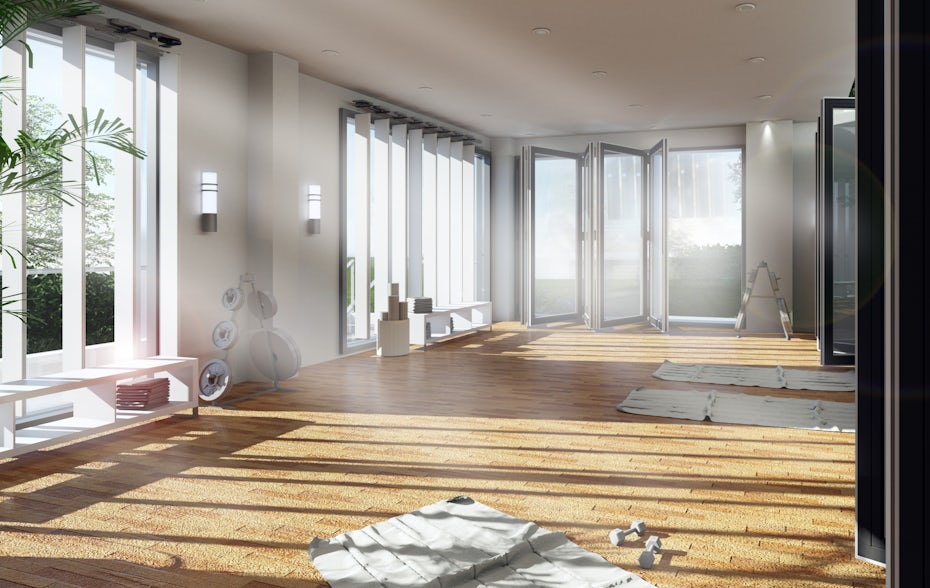
Your brand identity is the collection of everything that the customer sees, smells, touches, experiences and hears in relation to your brand. A gym is, generally speaking, a sensory, multidimensional space that provides its customers with a variety of exercise and fitness options. Because it is the sort of business that offers dynamic possibilities such as digital and physical class schedules, workout styles and instructors, a gym’s brand identity design has to be comprehensive and consistent.
Key elements of gym branding
Tone of voice and vocabulary
So much of a gym’s identity comes from how it addresses its clientele, whether through posters, social media posts, ads qne in class. Motivational quotes, keywords and even lingo like HIIT or “Romanian Deadlift” all contribute to what the gym brand expressing these sounds like and what it would like to convey.
A great example of how tone works in gym branding is fitness influencer Kayla Itsines’s “BBG” or Bikini Body Guide. Her workouts are immensely popular and this was initially partly due to the very visual promise of the name. However, as body positivity swept across the media, Itsines decided to change her brand’s name to keep in line with her audience’s values.
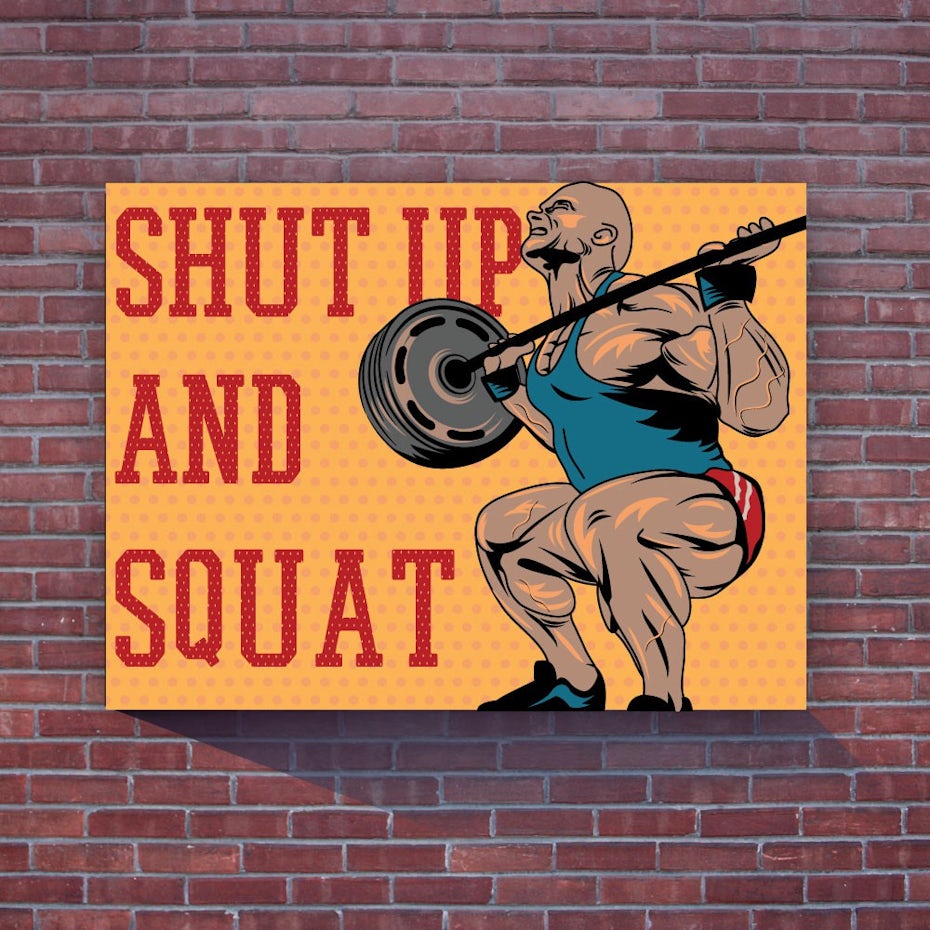
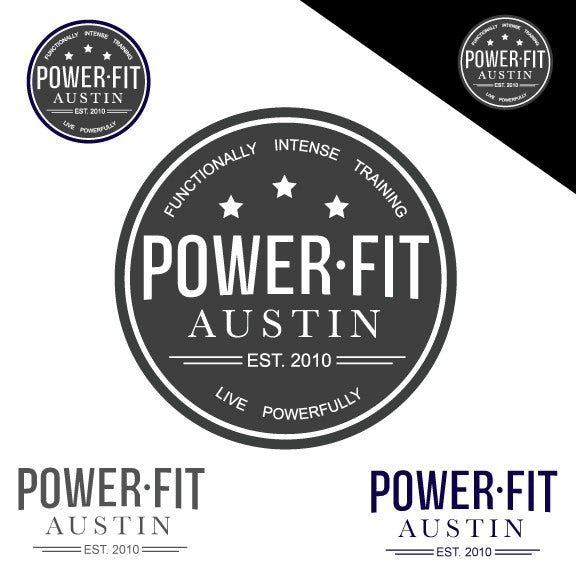
Your brand values influence your tagline, which is a really important means to connect with your audience. In the gym logo designs above, you see two examples of taglines: “Shut up and squat” and “Live powerfully”. One has a more commanding and dominating style, while the other opts for self-empowerment. Both are dictated by the tone of voice.
Color palette
Different colors can evoke different emotions in people and also really contribute to your brand personality. Color psychology and color theory play a big role in brand design. In gym branding, picking the colors that make sense for your gym brand’s identity is critical because the colors will be present throughout the space, inviting people in, motivating them, building associations with their endorphins.

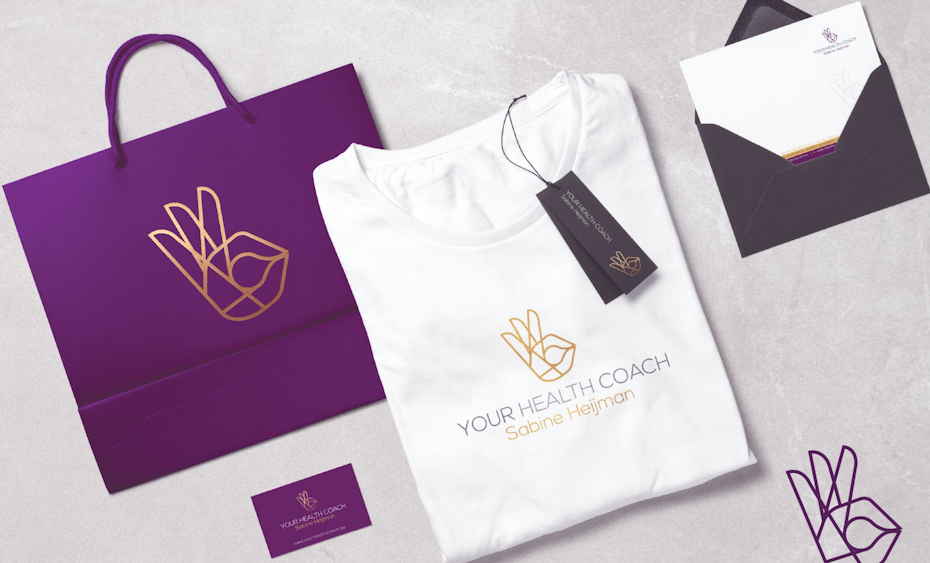
When choosing the color palette, think about everything that it will influence. The app, the lighting, the uniforms, everything that text will go over. For example, bright shades of red, yellow and green can be energizing but too much of it can overwhelm the eyes. Really picturing the colors of your brand identity elements will help you come up with a balanced palette that speaks to the emotions you want them to evoke.
Typography
The logo, signage, brochure, ads, should all emulate your gym’s style. You can communicate a great deal through typography. Is it bold, all caps or has block lettering? Just like colors, the letters and the words they make up will carry a lot of the gym’s voice and expression. Typography can communicate messages like directness, confidence or a sense of calm to its audience.
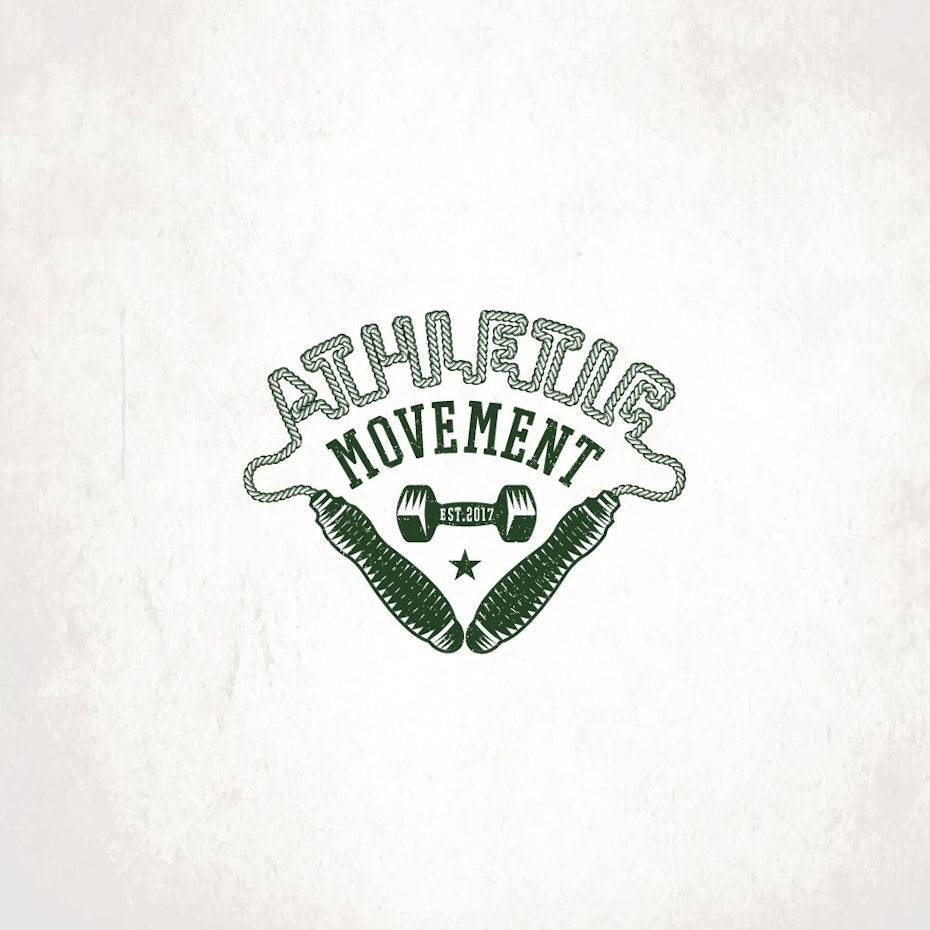
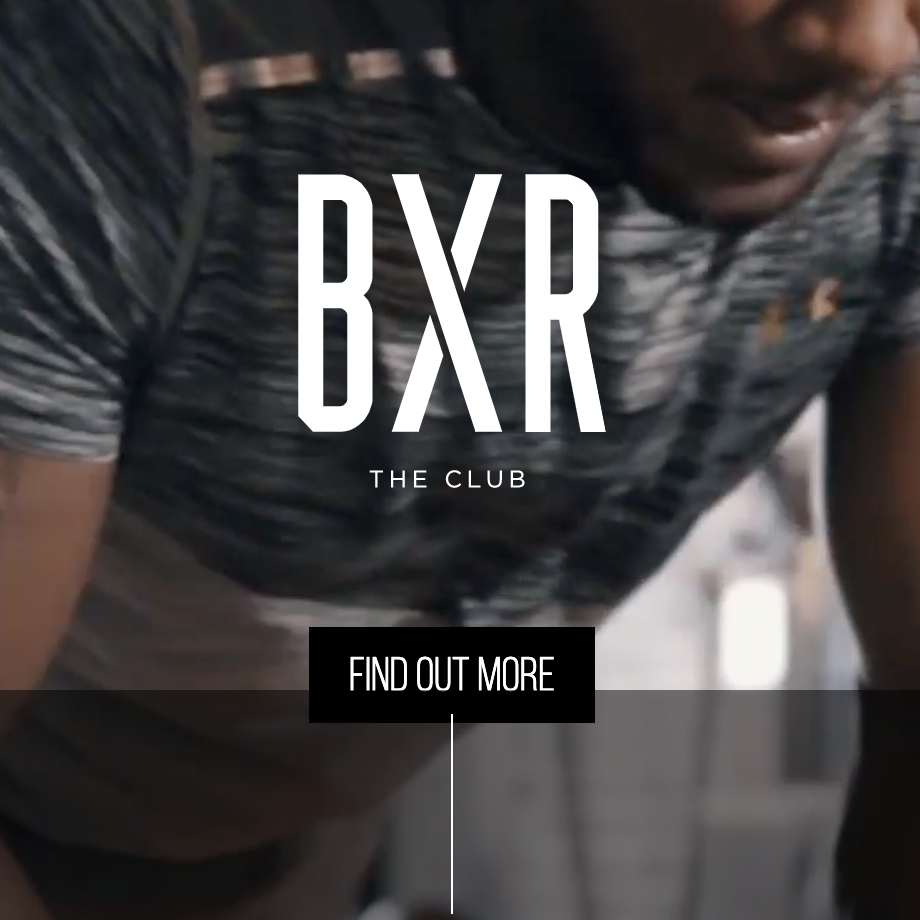
Sans serifs layered over negative space can convey a modern look. Brush fonts tend to have a softer and more welcoming feel while stencil can be great for a military, boot-camp type workout space. In the examples above, we see that BXR chooses simple and spaced out serifs in all caps. What this typography choice communicates is legibility, which is a stylistic choice but also a necessity considering the darker color palette and image-heavy website. The unfussy serif is clear and suits the blunt, strong name and logo, the spartan “BXR”.
On the other hand, the top-level designer Neatlines incorporates a much more classic serif with a distressed, vintage look and brilliantly incorporates the ropes into the name for the logo. The overall effect is a bit more “old-school” resembling a historic boxing gym. It adds a unique personality to its branding.
Imagery
Take a second to think of all the imagery that is commonly a part of gym branding: photos of people lifting weights, meditating, smiling faces on stationary bikes, a honed-in shot of sculpted body parts like abs or biceps.
“Fitspiration”, aka portraying body images to evoke aspirational emotions in viewers, is a big part of gym advertising, and similar images can be part of the overall brand identity of a gym as well. But it’s a fine line between promoting realistic, healthy goals for natural bodies versus using body ideals to body shame and eventually alienate audiences. When deciding what route you wish to go down, consider the value your brand is bringing into people’s lives—is it largely positive or negative?

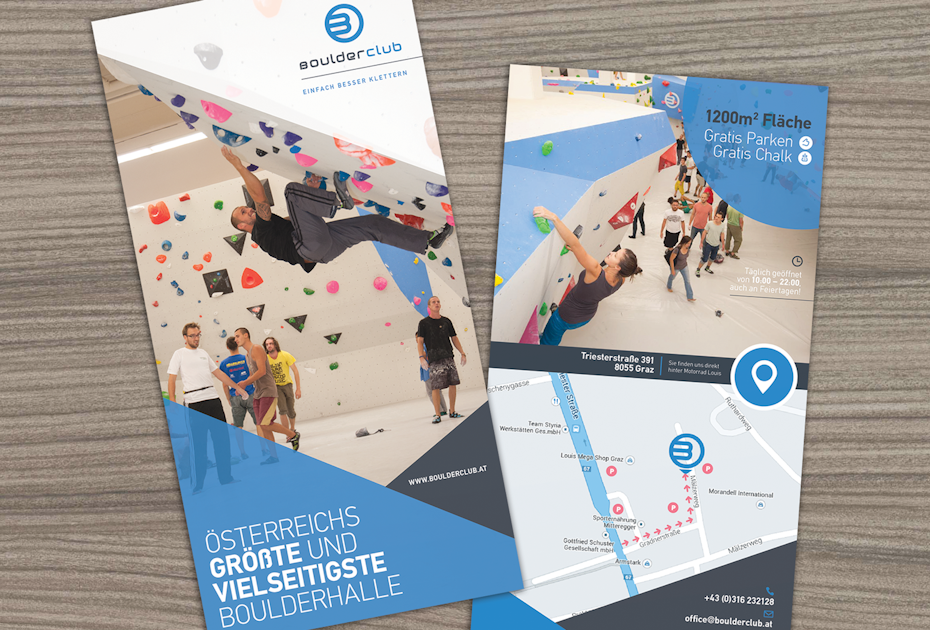
For a strength-building gym using the image of someone carrying very heavyweights may be innocuous and helpful. If your specialty is yoga or pilates, abstract imagery creating a calming atmosphere will probably be better suited to your brand environment.
Images do a lot of the work of expressing who you are and who you would like to invite to your gym. Are you championing muscle mass or wellness, community or self-motivation? Your visuals intro people to your brand and tell them what to expect—if you’re not catching the attention of the right people for you, you need to rethink your look.
Designing for gym branding
—
Name and logo
Like with branding anything else, the main goal while coming up with a name and a logo for your gym brand is making them both memorable and distinct. To come up with a name and logo, you should let your tone of voice and other brand identity elements guide you. A logo is what audiences see at every interaction with the brand and therefore should be the summation of a brand. It should be a concentrated symbolic representation of everything your gym brand is. It will be the building block for the rest of the branding and together form a holistic identity.
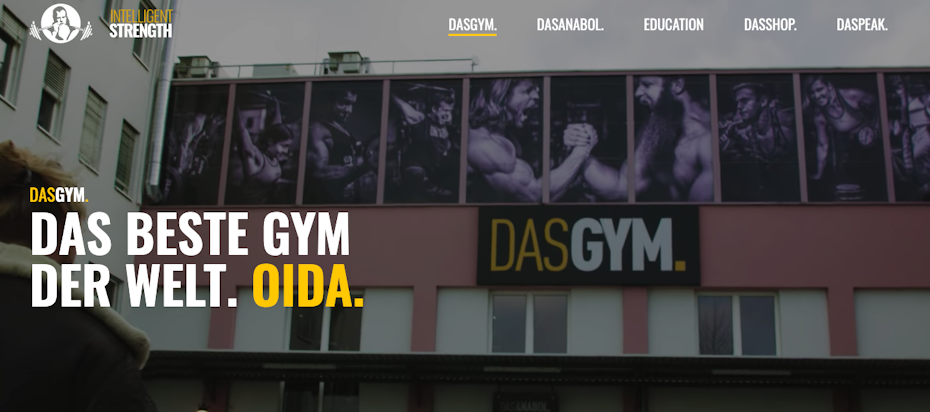
As an example, let’s think of DAS GYM, a strength-focused gym based in Vienna. The name “Das Gym” literally means “The Gym” and the logo is a black and white illustration of someone lifting what appears to be a very heavy weight. To name your gym “The Gym” is a very bold move, it suggests that this is the gym and there’s no other like it. It’s radical, it’s powerful and just through the name it makes itself one of a kind. There can only be one “The Gym”. The logo is similarly representational of something fundamental, universally known yet powerful. Everything about the branding is bold, direct and exerts strength.
Scent
Some fitness businesses have a distinct smell, and no, I am not referring to body odor. There are fragrances that are curated for a gym and sometimes you can smell it from the street. Equinox is a great example of this, you can smell their signature eucalyptus aroma as you approach on the street thanks to their laundry dryer vents. It’s so blended into their brand identity that they’ve chosen to sell it online and at their gyms. But why?
Smell can have a profound effect on memory and emotions. A distinct scent can bring forth a feeling, good or bad, that the person previously experienced with that smell. Physical workouts tend to release chemicals called endorphins which are also called “feel-good hormones”. Imagine having a scent that your brain associated with those hormones. It would be alluring to return to where and how you felt that emotion in the first place. A distinct scent can have this effect.
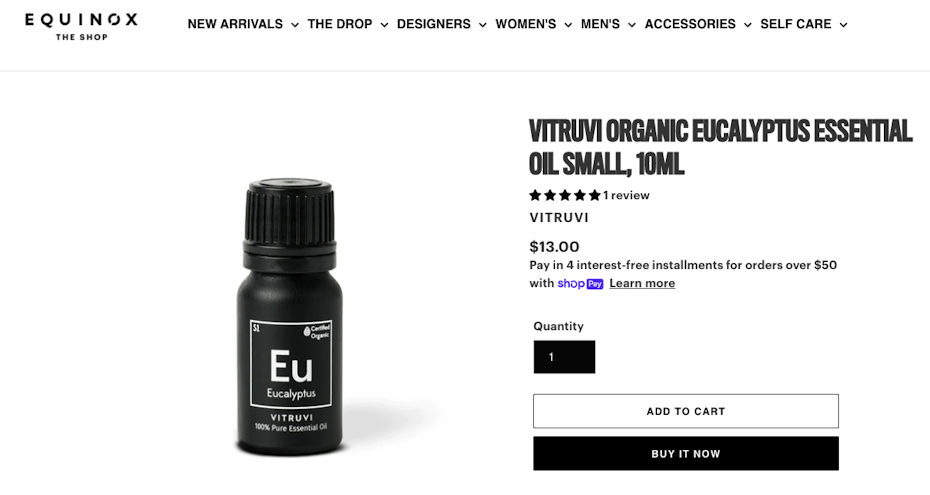
This is also sometimes referred to as “scent marketing”. The fragrance could be present in locker rooms, the entrance and even the workout rooms. It’s worth considering. A space dedicated to rehabilitative stretching would need calming aromas like lavender, as opposed to a workout space for cardio that could use something a lot more energizing like citrus or mint.
Sound
Sometimes, the squeaks and thumps of a ball on a court is enough to create ambiance. But sometimes it’s great to have mellow, acoustic music as you welcome people in or upbeat pop music as they leave the workout to keep that sense of accomplishment going. It’s also not unusual for teachers at a gym or fitness business to create and share playlists.
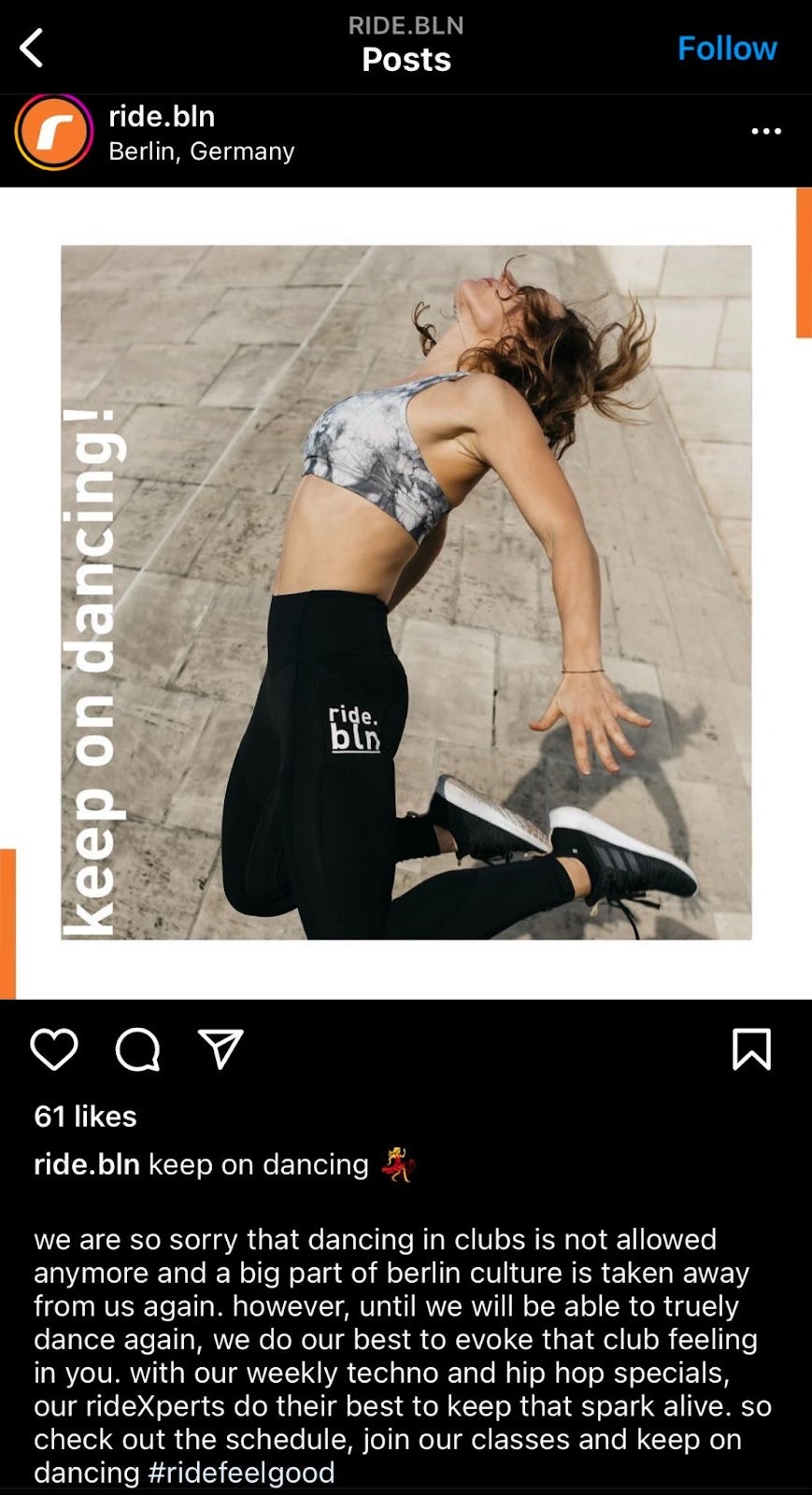
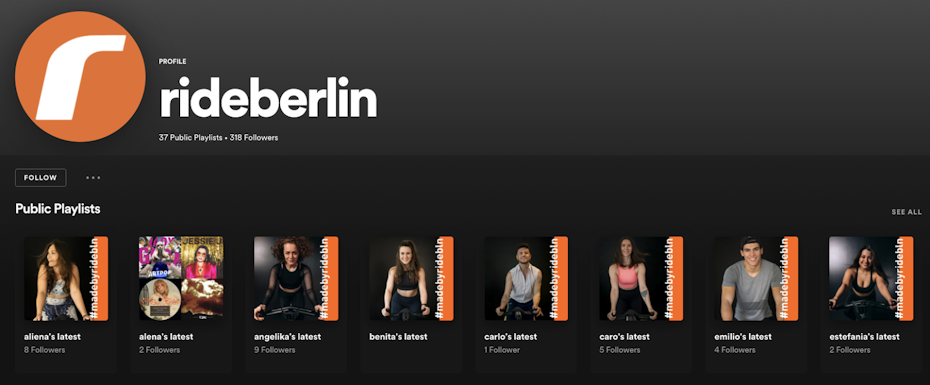
The sound of your gym will have to be in line with the values and personality you’ve come up with for your gym. The ride.bln studio in Berlin has “Techno Special”—of course it does—where the spinning class takes place with a hard techno soundtrack. It’s not just a nod to the city’s electronic music culture, it’s also a ritual and a signature sound that brands the ride.bln workout. They pay attention to thoughtfully curating music for all of their classes to offer users something more interactive and fun than a ‘usual’ gym.
The space
Gym branding is holistic and the interior design of your space is crucial. Layout, facilities, lighting, equipment, windows face (or if there are any windows at all) are all things to consider.

Values and voice guide the way to designing a gym space. For example, the photos above are from SkyWellness, a gym based in Belgrade. True to its name and overall voice, the gym is spacious and well-lit, with minimal geometric shapes. The open plan makes the layout feel a lot roomier without needing to cut back on any of the amenities or facilities.
Website, app and social channels
Presently, a gym’s online existence is equally important as its in-person existence. In fact, sometimes a gym brand solely exists online, offering virtual classes through its website, app or social media channels.
During COVID-19 many gym websites and apps were put to the test. Many of them had to include streaming options, be very clear and quickly share masking and testing rules in facilities. Besides the practicalities, they also had to make sure that their digital representatives were true to themselves. This time period only strengthened the already shifting ways of how and when we work out.
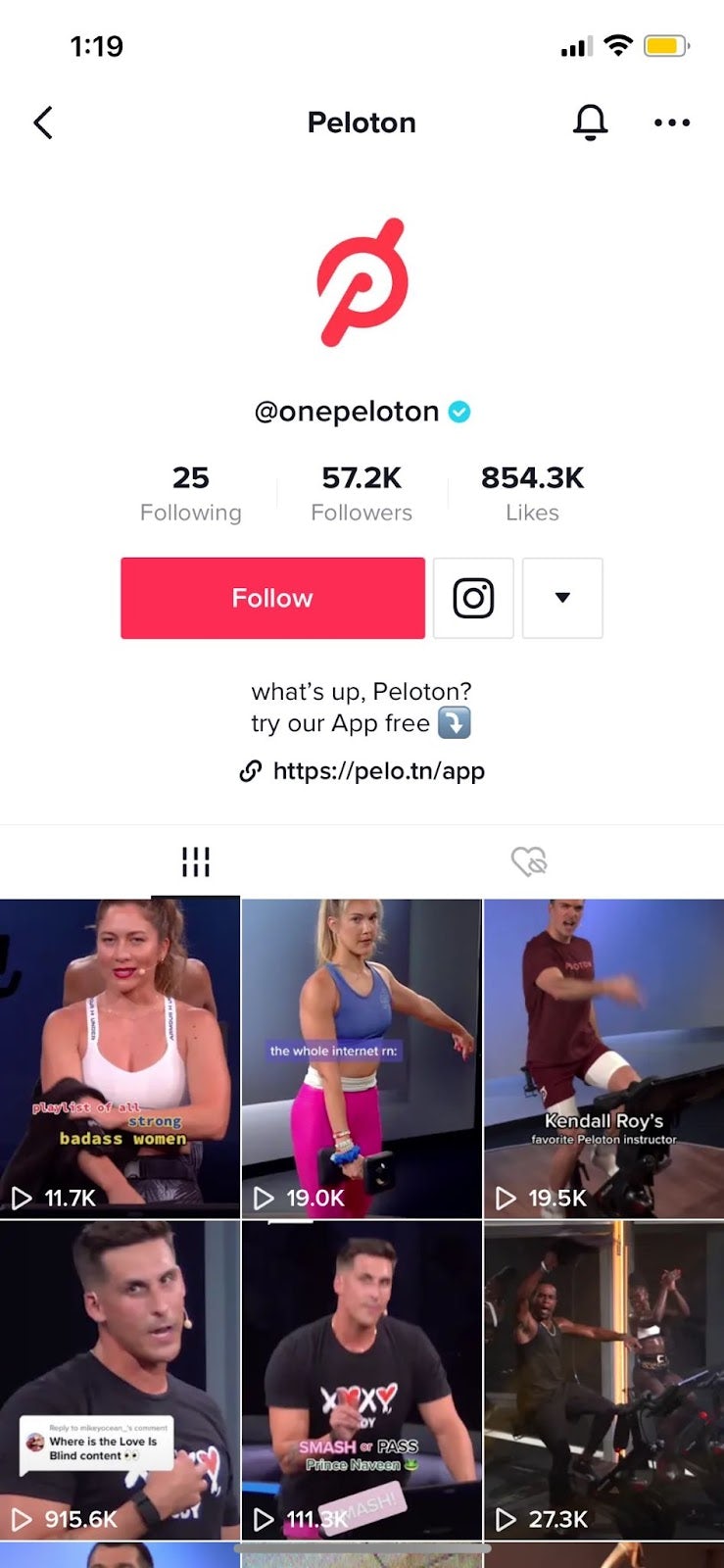

For example, #FitTok, or Fitness TikTok is one of the most popular categories on the platform. It isn’t just a great tool for fitness influencers but also for gym brands that want to reach and develop relationships with a global audience. In the examples above, Peloton’s TikTok page uses the medium to take part in pop-culture conversations, communicate the brand’s aesthetic and voice, their sound, schedule and also guide people to click into the brand’s app.
In focus: three gym branding case studies
—
We’ve been looking at specific elements of well-executed gym branding. To get a more wholesome idea of how your brand identity and design elements can work with each other to create unforgettable gym branding, let’s delve deeper into some examples. The gym brand examples below really showcase how a strong core concept can flourish into an all-around comprehensive, consistent and unique brand identity.
1. La Belle Equipe
La Belle Equipe (meaning “The Beautiful Team”) is a gym in Paris that focuses on Muay Thai. They state their values right on their homepage: “Commitment, Camaraderie and Benevolence”.
The concept of the gym is creating a living space that is not limited to a workout space. There’s a mental health drive to their services, which they express often on their website. The bright colors, illustrations and the soft and well-lit space all suggest comfort and self-improvement, rather than the dark hues and muscle-focused images that usually brand other boxing gyms.

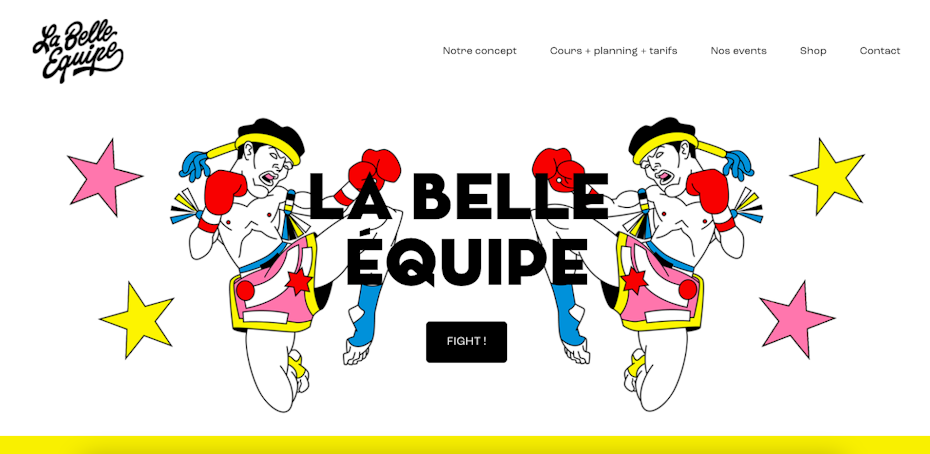
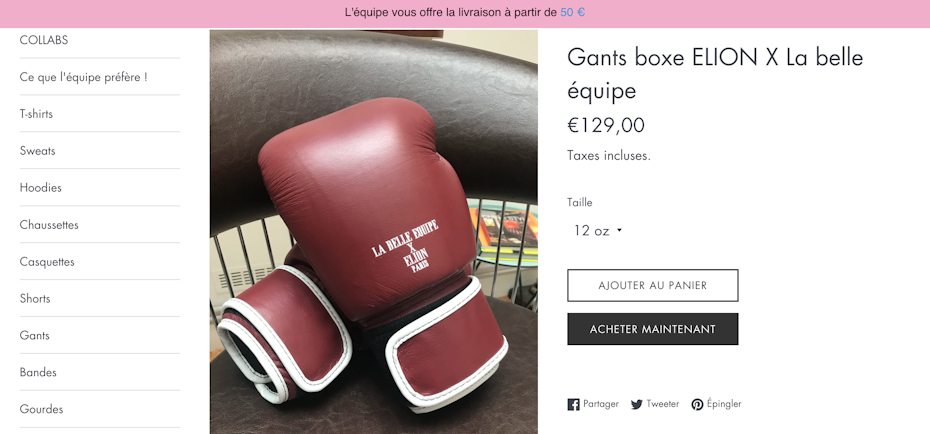
Although the workout is exclusively Muay Thai, the gym offers group and one on one lessons, lessons that are exclusively for women or for kids. They have a shop, selling branded products that their consumers can take out of the gym and into the rest of their lives. There’s even a tattoo parlor and a hair salon within the building, so consumers can style their appearances with the brand. The brand began as a gym and has expanded to represent an identity or cult lifestyle for their audiences. It’s a prime example of how to break out of a traditional ‘gym’ mould and build a loyal following.
2. Hagius
Hagius, a gym based in Berlin, is another great example of impeccably consistent branding. The gym offers a small variety of classes and everything about it says “thoughtfully curated”.
The typography never strays away from a slim and elegant Sans Serif, even on the logo. The color palette is similarly simple, black, white or gentle pastels. Layered against the space, it all gives an impression of becoming light or having space.

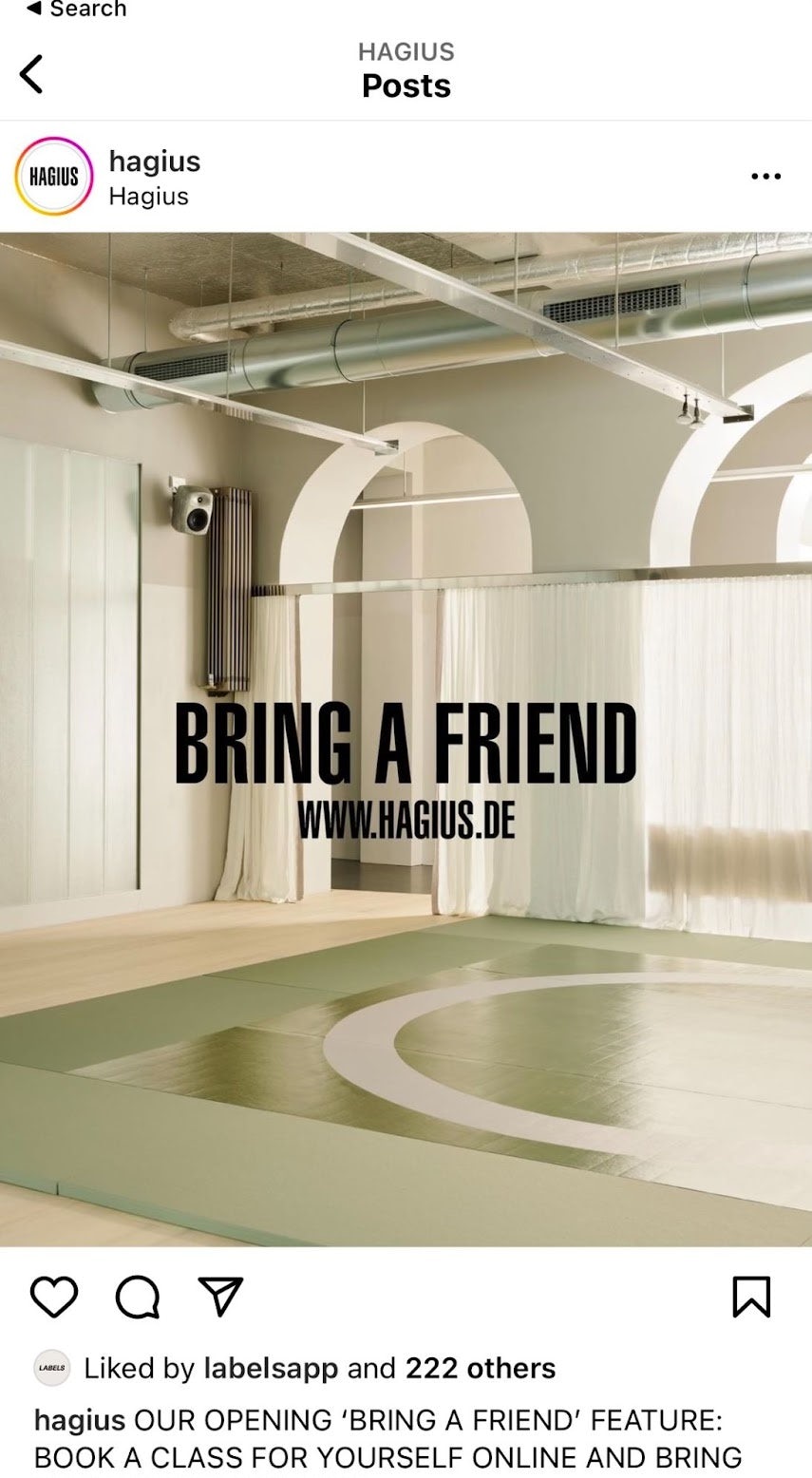

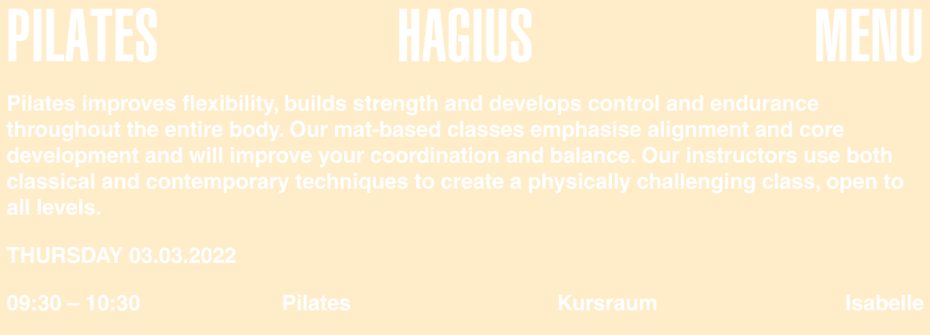
On the About page, Hagius never describes itself as a “gym” but rather as a “programme” that addresses the body as well as the mind. The space is sleek with lots of exposed materials. The branding is inviting, minimal, soothing, and full of light. Hagius promotes an experience, rather than leaning on visual ideals of bodily perfection. And looking at their imagery, attending this gym feels more like a visit to an art gallery than an intense spin class.
3. Ritual
Lastly, based in Hong Kong, Ritual defines itself as “The 30-minute gym”. The concept is having affordable, quick and high-intensity exercises in a community-focused setting. Throughout the website and social channels, there is emphasis on affordable prices (deals, savings and so on), time and community.
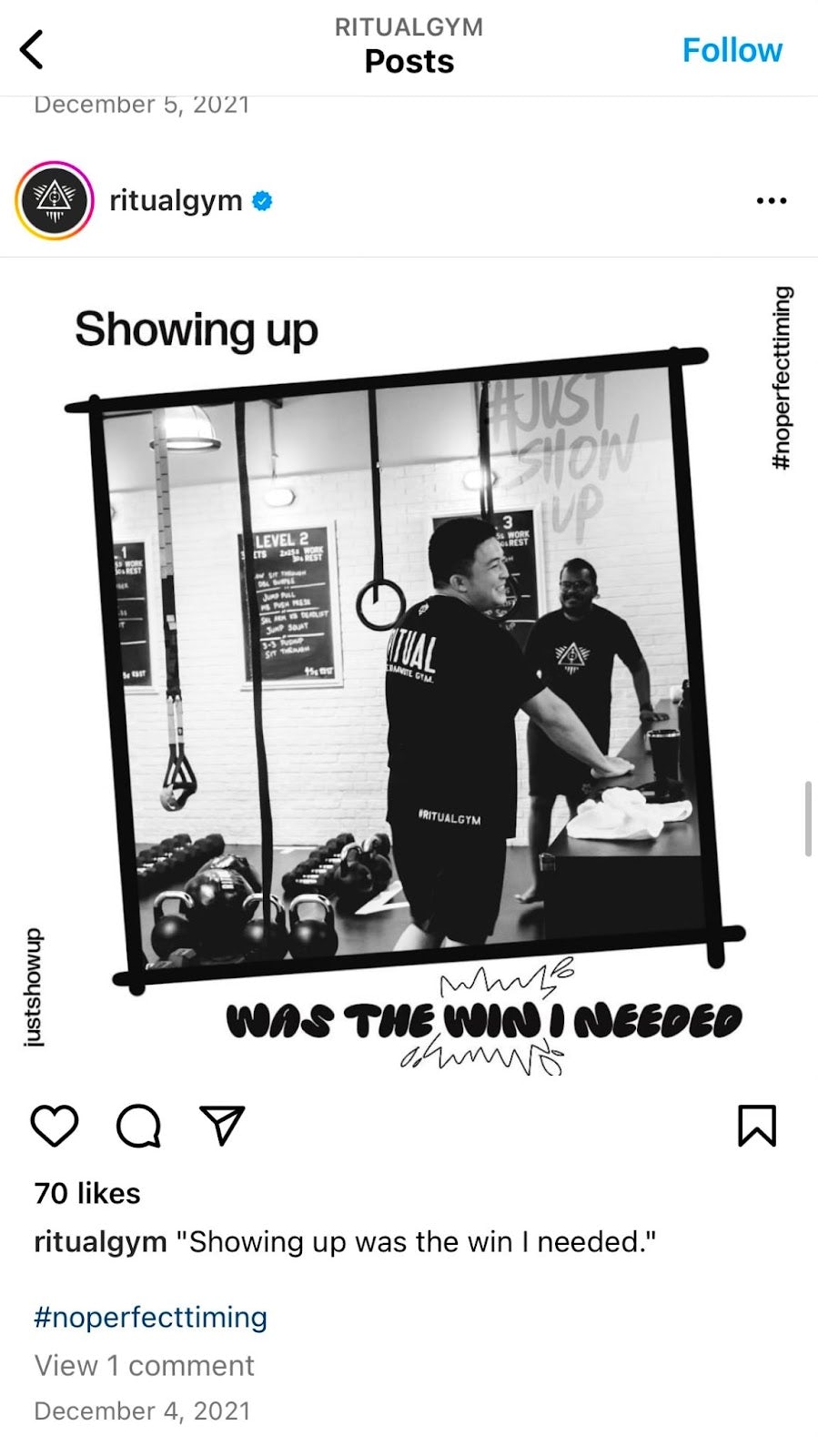
The motivational language of their choice is “Showing up”. The idea is to get the customers to visit regularly at short intervals. The time and price ask aims to guarantee repeat visits: it is low cost and efficient. Everything about the web design, the smiling faces, the typography and the language reads like an open book. The branding tells you that what you see is what you will get. 30-minute workouts that are easy to cancel and rebook, they are even transparent about what your training will involve.
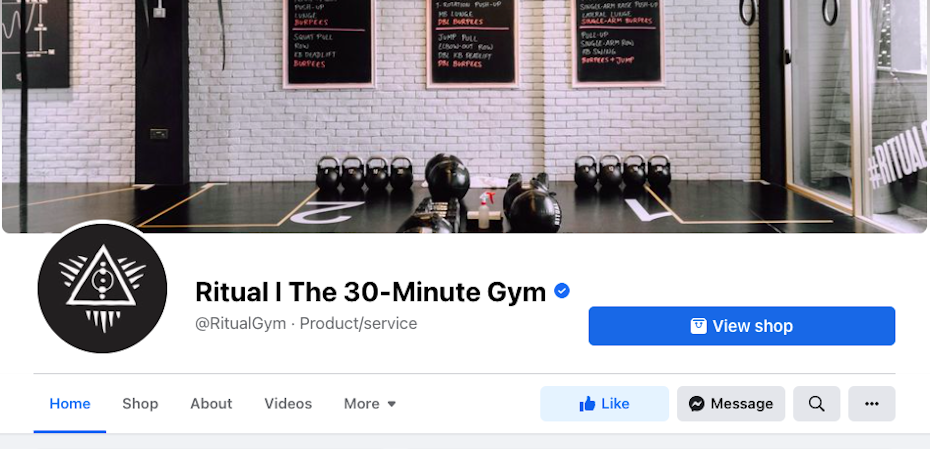

As part of their branding, Ritual makes their gym feel approachable to those who are usually intimidated by the idea of a gym. They diminish the stressful commitment that’s so often lauded at other gyms in favor for a pressure-free approach. From images of beaming instructors to motivational quotes, Ritual wants to support their clients to adopt fitness into their busy lifestyles.
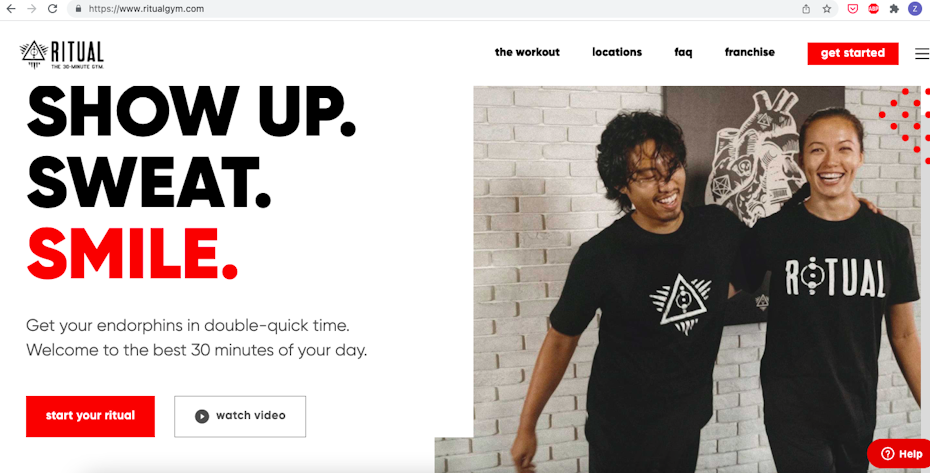
They emphasize their straight-up approach with a basic palette of red, white and black. The branding elements are intentionally not over-stylized. The logo utilizes classic shapes as an ode to the name, something timeless that meets expectations, a ritual.
Shape and strengthen your gym brand
—
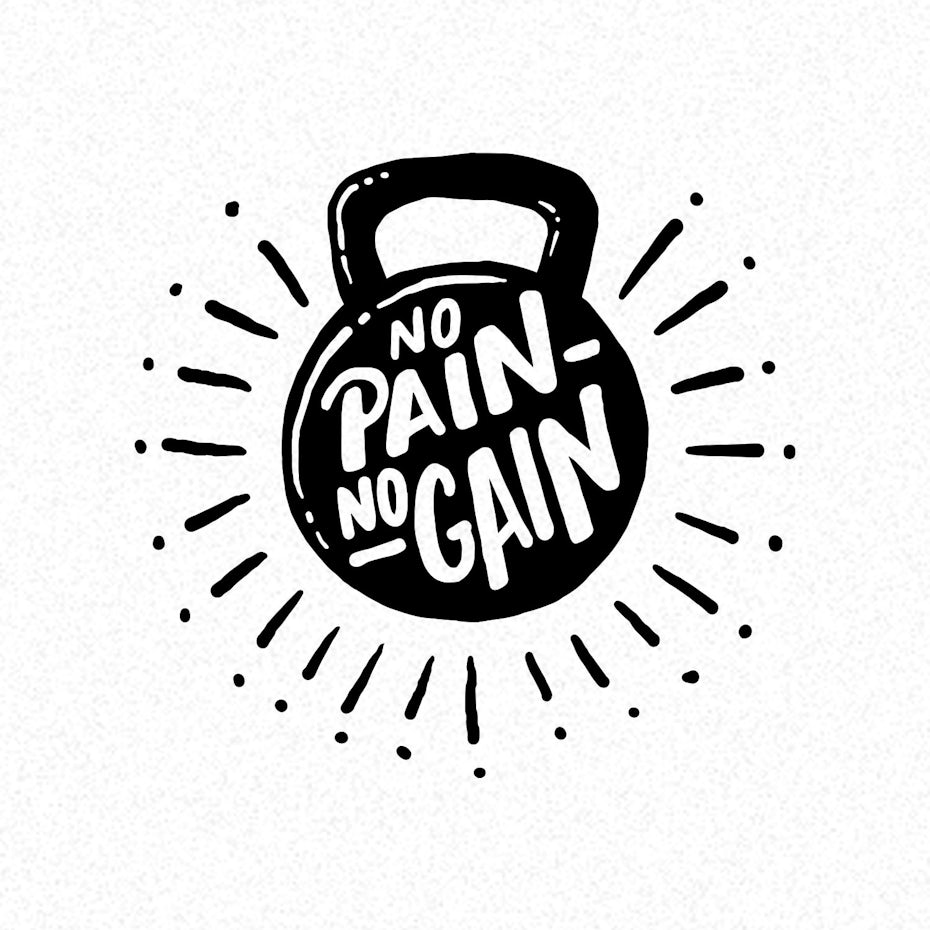
The pillars of gym branding are: know the gym and know its community. Answering as many questions as possible to really get to the roots of why this fitness business will exist and stand out will make branding it so much clearer and more powerful.
In all the examples above, it’s clear to see that successful gym branding really captures what’s special about the individual brand and consistently shares that in its messaging.
The very idea of a gym supports audiences to both challenge and care for themselves, you must find how to communicate this in a more unique and authentic light than your competitors.
Want to innovate your brand identity?
Our talented designers can take care of it.
The post Gym branding: the ultimate guide to flex your strategy on appeared first on 99designs.
